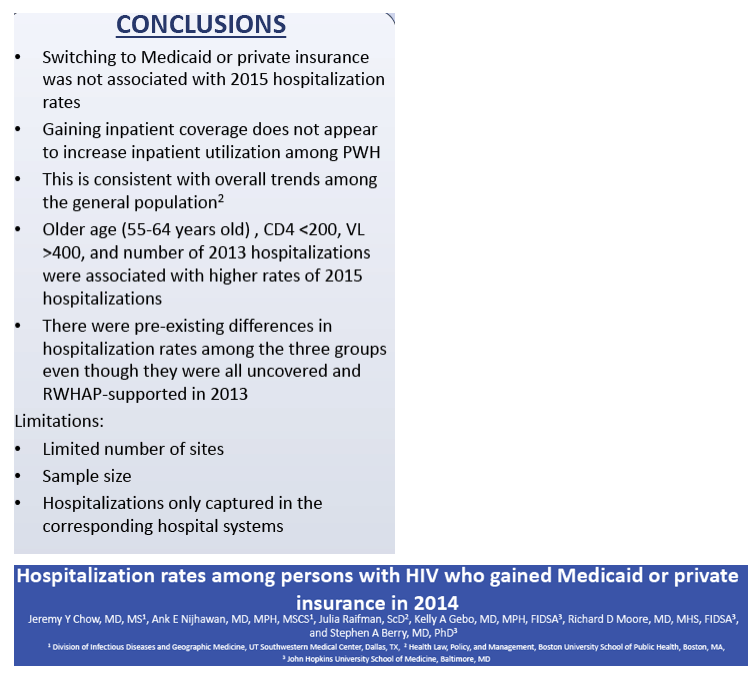 |
 |
 |
| |
Hospitalization rates among persons with HIV who gained Medicaid or private insurance in 2014: Moving From Ryan White to Medicaid or Private Insurance Did Not Boost Hospital Use; BUT Older HIV+ 55-64 Had Double the Hospitalization Rate; Low CD4 & Detectable Viral load also had Higher Hospitalization Rates
|
| |
| |
IDWeek 2018, October 3-7, 2018, San Francisco

Mark Mascolini
When low-income people with HIV moved from safety-net Ryan White coverage to Medicaid or private insurance under the Affordable Care Act, gaining inpatient coverage did not spawn a surge in hospital admissions [1]. In fact, the hospitalization rate waned slightly after people got inpatient benefits with Medicaid or private insurance.
Thousands of people with HIV relied solely on the Ryan White HIV/AIDS Program for outpatient medical and support services until the Affordable Care Act (Obamacare) made Medicaid and private insurance available to many in 2014. Ryan White offers no inpatient support, while Medicaid and private insurance typically do. Whether this large uptake of Medicaid and private insurance by low-income people with HIV would spur a jump in hospital admissions remained unknown until this study by HIV Research Network investigators.
The study involved 1634 people from 3 HIV Research Network sites, including 2 that expanded Medicaid through the Affordable Care Act and 1 nonexpansion site. Participants had relied only on Ryan White coverage in 2013 and remained in care through 2015. The primary outcome was the 2015 hospitalization rate. To identify factors independently associated with hospitalization in 2015, the researchers used negative binomial regression adjusted for gender, race, age, HIV risk factor, CD4 count, viral load, clinic site, and number of 2013 hospital admissions.
The analysis focused on 1174 people who continued to rely solely on Ryan White, 352 who switched to Medicaid, and 108 who switched or private insurance. In those 3 groups proportions of women were 24%, 38%, and 26%; proportions of blacks 39%, 71%, and 48%; proportions of Hispanics 46%, 5%, and 29%; and proportions of whites 15%, 24%, and 23%.
From 2013 to 2015 hospitalization rates fell marginally in all 3 insurance groups:
-- Remained on Ryan White: 8.4 to 6.3 per 100 person-years
-- Switched to Medicaid: 21.3 to 20.2 per 100 person-years
-- Switched to private insurance: 7.4 to 3.7 per 100 person-years
Multivariate regression analysis identified 4 independent predictors of hospital admission in 2015:
1. Compared with 18- to 34-year-olds, 55- to 64-year-olds had a doubled hospitalization rate (incidence rate ratio [IRR] 2.18, 95% confidence interval [CI] 1.08 to 4.41). (Compared with the youngest age group, being 35-44 of 45-54 did not affect hospital admission rate.)
2. A CD4 count below 200 versus at or above 500 raised the hospitalization rate 5 times (IRR 5.00, 95% CI 2.60 to 9.61).
3. More hospital admissions in 2013 doubled the 2015 hospitalization rate (IRR 1.97, 95% CI 1.44 to 2.68).
4. A viral load at or below 400 almost halved the hospitalization rate (IRR 0.55, 95% CI 0.32 to 0.94).
In this analysis switching to Medicaid or to private insurance was not associated with 2015 hospitalization rates in this HIV group.
"Gaining inpatient coverage," the researchers concluded, "does not appear to increase inpatient utilization among people with HIV."
Reference
1. Chow J, Nijhawan A, Raifman J, Gebo K, Moore R, Berry S. Hospitalization rates among persons with HIV who gained Medicaid or private insurance in 2014. IDWeek 2018, October 3-7, 2018, San Francisco. Abstract 1906. Poster at https://idsa.confex.com/idsa/2018/webprogram/Paper70309.html



|
| |
|
 |
 |
|
|